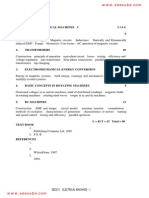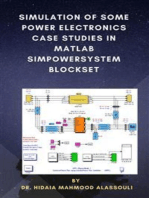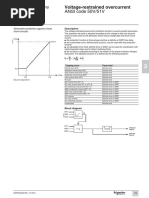Tutorial 2
Uploaded by
Lionel TanTutorial 2
Uploaded by
Lionel TanElectrical Machines and Motors EME4323 Tutorial 2
3-1. The simple loop is rotating in a uniform magnetic field shown in Figure 3-1 has the
following characteristics:
B = 1.0 T to the right
l = 0.3 m
r = 0.1 m
m = 377 rad/s
(a) Calculate the voltage etot(t) induced in this rotating loop.
(b) What is the frequency of the voltage produced in this loop?
(c) Suppose that a 10 resistor is connected as a load across the terminals of the loop.
Calculate the current that would flow through the resistor.
(d) Calculate the magnitude and direction of the induced torque on the loop for the
conditions in (c).
(e) Calculate the instantaneous and average electric power being generated by the loop for
the conditions in (c).
(f) Calculate the mechanical power being consumed by the loop for the conditions in (c).
How does this number compare to the amount of electric power being generated by the
loop?
3-2. Develop a table showing the speed of magnetic field rotation in ac machines of 2, 4, 6, 8,
10, 12, and 14 poles operating at frequencies of 50, 60, and 400 Hz.
3-3. The first ac power system in the USA ran at a frequency of 133 Hz. If the ac power for this
system were produced by a 4-pole generator, how fast would the shaft of the generator have
to rotate?
3-4. A three-phase Y-connected four-pole winding is installed in 24 slots on a stator. There are
40 turns of wire in each slot of the windings. All coils in each phase are connected in series.
The flux per pole in the machine is 0.060 Wb, and the speed of rotation of the magnetic
field is 1800 r/min.
(a) What is the frequency of the voltage produced in this winding?
(b) What are the resulting phase and terminal voltages of this stator?
3-5. A three-phase -connected six-pole winding is installed in 36 slots on a stator. There are
150 turns of wire in each slot of the windings. All coils in each phase are connected in
Electrical Machines and Motors EME4323 Tutorial 2
series. The flux per pole in the machine is 0.060 Wb, and the speed of rotation of the
magnetic field is 1000 r/min.
(a) What is the frequency of the voltage produced in this winding?
(b) What are the resulting phase and terminal voltages of this stator?
3-6.
A three-phase Y-connected 60-Hz two-pole synchronous machine has a stator with 5000
turns of wire per phase. What rotor flux would be required to produce a terminal (line-toline) voltage of 13.2 kV?
3-8. If an ac machine has the rotor and stator magnetic fields shown in Figure P3-1, what is the
direction of the induced torque in the machine? Is the machine acting as a motor or
generator?
3-10 In the early days of ac motor development, machine designers had great difficulty
controlling the core losses (hysteresis and eddy currents) in machines. They had not yet
developed steels with low hysteresis, and were not making laminations as thin as the ones
used today. To help control these losses, early ac motors in the USA were run from a 25 Hz
ac power supply, while lighting systems were run from a separate 60 Hz ac power supply.
(a) Develop a table showing the speed of magnetic field rotation in ac machines of 2, 4, 6,
8, 10, 12, and 14 poles operating at 25 Hz. What was the fastest rotational speed available
to these early motors?
(b) For a given motor operating at a constant flux density B, how would the core losses of
the motor running at 25 Hz compare to the core losses of the motor running at 60 Hz?
(c) Why did the early engineers provide a separate 60 Hz power system for lighting?
3-11 In later years, motors improved and could be run directly from a 60 Hz power supply. As a
result, 25 Hz power systems shrank and disappeared. However, there were many perfectlygood working 25 Hz motors in factories around the country that owners were not ready to
discard. To keep them running, some users created their own 25 Hz power in the plant
using motor-generator sets.
Electrical Machines and Motors EME4323 Tutorial 2
A motor generator set consists of two machines connected on a common shaft, one acting
as a motor and the other acting as a generator. If the two machines have different numbers
of poles but exactly the same shaft speed, then the electrical frequency of the two machines
will be different due to Equation (3-34). What combination of poles on the two machines
could convert 60 Hz power to 25 Hz power?
f se
n sm P
120
You might also like
- AC Machinery Fundamentals: 1.0 T To The Right 0.3 MNo ratings yetAC Machinery Fundamentals: 1.0 T To The Right 0.3 M3 pages
- Chapman Electric Machinery Fundamentals 5th c2012 Solutions ISMNo ratings yetChapman Electric Machinery Fundamentals 5th c2012 Solutions ISM8 pages
- EN213201 Ep1 AC Machinery Fundamentals FPNo ratings yetEN213201 Ep1 AC Machinery Fundamentals FP58 pages
- EENG492 Extended Assignment Spring 2019-2020 - v4No ratings yetEENG492 Extended Assignment Spring 2019-2020 - v44 pages
- Exercise Problems Electrical Machines 291010No ratings yetExercise Problems Electrical Machines 2910109 pages
- En - o2.3 - Eee - Exp7 - 4 Induction Machines (1)No ratings yetEn - o2.3 - Eee - Exp7 - 4 Induction Machines (1)73 pages
- Assignment Synchronous Generator and Induction Motor100% (1)Assignment Synchronous Generator and Induction Motor20 pages
- 2.1 Syllabus: Ee2251 - Electrical Machines - INo ratings yet2.1 Syllabus: Ee2251 - Electrical Machines - I22 pages
- Unit-I Permanent Magnet Synchronous Motor Ref: Special Electrical Machines by Gnanavadivel100% (2)Unit-I Permanent Magnet Synchronous Motor Ref: Special Electrical Machines by Gnanavadivel51 pages
- Power System Transient Analysis: Theory and Practice using Simulation Programs (ATP-EMTP)From EverandPower System Transient Analysis: Theory and Practice using Simulation Programs (ATP-EMTP)No ratings yet
- Exam Electrical Machines and Drives (ET4117) : Grid Back EMF Time (S)No ratings yetExam Electrical Machines and Drives (ET4117) : Grid Back EMF Time (S)10 pages
- Synchronous Machines Tutorial Problems SetNo ratings yetSynchronous Machines Tutorial Problems Set2 pages
- EE107!1!2 AC Machinery Fundamentals CompleteNo ratings yetEE107!1!2 AC Machinery Fundamentals Complete42 pages
- Synchronous Achine: António Dente Célia de Jesus February 2014No ratings yetSynchronous Achine: António Dente Célia de Jesus February 201410 pages
- Simulation of Some Power Electronics Case Studies in Matlab Simpowersystem BlocksetFrom EverandSimulation of Some Power Electronics Case Studies in Matlab Simpowersystem BlocksetNo ratings yet
- Simulation of Some Power Electronics Case Studies in Matlab Simpowersystem BlocksetFrom EverandSimulation of Some Power Electronics Case Studies in Matlab Simpowersystem BlocksetNo ratings yet
- Some Power Electronics Case Studies Using Matlab Simpowersystem BlocksetFrom EverandSome Power Electronics Case Studies Using Matlab Simpowersystem BlocksetNo ratings yet
- VSC-FACTS-HVDC: Analysis, Modelling and Simulation in Power GridsFrom EverandVSC-FACTS-HVDC: Analysis, Modelling and Simulation in Power GridsNo ratings yet
- The Influence of Leadership in Fisheries Co-Management: The Case of Tam Giang Lagoon, VietnamNo ratings yetThe Influence of Leadership in Fisheries Co-Management: The Case of Tam Giang Lagoon, Vietnam17 pages
- Tailings For Water Dam 2. Moisture Control For Road Construction 3. Water Tank Containment 4. De-Watering Project 5. AirportNo ratings yetTailings For Water Dam 2. Moisture Control For Road Construction 3. Water Tank Containment 4. De-Watering Project 5. Airport1 page
- (APPENDIX B) CHAROEN-POKPHAND-GROUP-attachment-human-rights-policy PDFNo ratings yet(APPENDIX B) CHAROEN-POKPHAND-GROUP-attachment-human-rights-policy PDF5 pages
- Supported/: 1. Is GCL A Competitor To HDPE Geomembrane?No ratings yetSupported/: 1. Is GCL A Competitor To HDPE Geomembrane?1 page
- Stormwater - Retention Pond (Wet Pond) vs. Detention Pond (Dry Pond)100% (3)Stormwater - Retention Pond (Wet Pond) vs. Detention Pond (Dry Pond)2 pages
- 40% Test & Assignment + 60% Exam: Segi University Mechanical Engineering Eme 4333 - Advanced ThermodynamicsNo ratings yet40% Test & Assignment + 60% Exam: Segi University Mechanical Engineering Eme 4333 - Advanced Thermodynamics1 page
- File - Name - 20130722162436 - Malaysia Country Report-Environmental Safety 2012No ratings yetFile - Name - 20130722162436 - Malaysia Country Report-Environmental Safety 201213 pages
- Buchholz Relay in Transformer - Buchholz Relay Operation and Principle - Electrical EngineeringNo ratings yetBuchholz Relay in Transformer - Buchholz Relay Operation and Principle - Electrical Engineering3 pages
- EL7047: Risk and Reliability in Electrical Energy SystemsNo ratings yetEL7047: Risk and Reliability in Electrical Energy Systems22 pages
- Telecommunications Technician: Practical Exercise 8No ratings yetTelecommunications Technician: Practical Exercise 822 pages
- Sync Generator Rotor Position EstimationNo ratings yetSync Generator Rotor Position Estimation70 pages
- Enterprisewise Scada System For Drilling & Production Facilities0% (1)Enterprisewise Scada System For Drilling & Production Facilities74 pages
- Electronic Boost Solenoid Installation InstructionsNo ratings yetElectronic Boost Solenoid Installation Instructions5 pages
- Obstacle Detection in Self-Controlled CarsNo ratings yetObstacle Detection in Self-Controlled Cars11 pages
- Overhead Transmission Lines, Gas Insulated Lines and Underground CablesNo ratings yetOverhead Transmission Lines, Gas Insulated Lines and Underground Cables8 pages
- Troubleshooting and Repair - Electrocardiograph (Schiller AT-1)No ratings yetTroubleshooting and Repair - Electrocardiograph (Schiller AT-1)7 pages
- Compresseur Acc Cubigell Electrolux MS34TBNo ratings yetCompresseur Acc Cubigell Electrolux MS34TB3 pages
- Sepam Series 80 Voltage Restraint OvercurrentNo ratings yetSepam Series 80 Voltage Restraint Overcurrent8 pages
- Sharp Serial Dot Matrix Printer DP-730 Parts & ServiceNo ratings yetSharp Serial Dot Matrix Printer DP-730 Parts & Service44 pages
- Experiment No. 03 Polarity and Ratio Tests of Single Phase TransformerNo ratings yetExperiment No. 03 Polarity and Ratio Tests of Single Phase Transformer6 pages
- Dokumen - Tips 5902 A320i A420i Product Manual English Edp002568 2 1 (301 332)No ratings yetDokumen - Tips 5902 A320i A420i Product Manual English Edp002568 2 1 (301 332)32 pages
- Design of Static Flip-Flops For Low-Power DigitalNo ratings yetDesign of Static Flip-Flops For Low-Power Digital8 pages
- Sinumerik 808D Service Guide: Training ManualNo ratings yetSinumerik 808D Service Guide: Training Manual44 pages







































































































